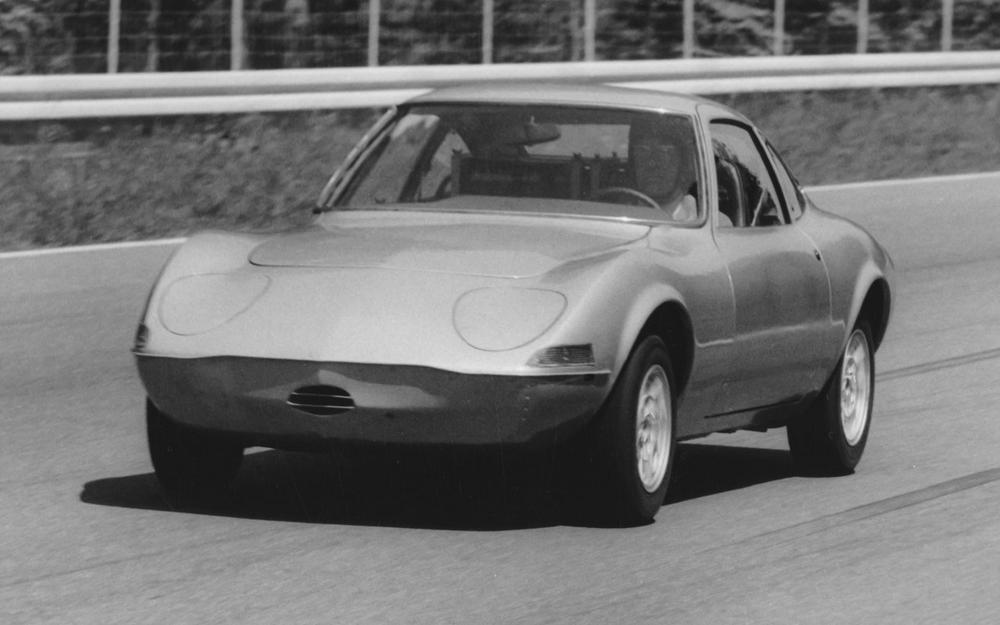- Six pack: Modified Opel GT sets world speed records for battery-electric cars
- Special development: Two electric motors, jet-fighter batteries, high-pressure tyres
- Bare necessities: No air intakes, mirrors or door handles
- First BEV with the Blitz: “Elektro GT” is predecessor of today’s Corsa-e
- Need for speed: Georg von Opel in wheel tracks of cousin and “rocket man” Fritz
1971 was the year that Apollo 15 astronauts become the first to ride in an all-electric lunar rover after landing on the Moon. That year a unique Opel GT also proved that electric motors were not just for golf buggies. For on May 17-18, 1971 at the “Hockenheimring” racetrack in Germany, Georg von Opel set out to establish new speed records for electric cars with a specially prepared and modified sports car – the Opel “Elektro GT”. In the end the car set six world records.
The grandson of Opel-founder Adam Opel, a successful businessman and a world-class athlete, Georg von Opel’s record attempt with the “Elektro GT” was not only “proof of concept” for the future of battery electric vehicles (BEV); it was also the continuation of a family tradition. His cousin “Raketen-Fritz” (rocket-man Fritz) grabbed the headlines from 1927 to 1929 with rocket-powered demonstrations that reached their peak at the Avus racetrack on May 23, 1928 with the RAK 2 and a top speed of 238 km/h.
The “Elektro GT” was equipped with two Bosch DC electric motors that together produced 88 kW (120 hp) of continuous power and a peak power output of even 118 kW (160 hp).
Varta provided the four nickel-cadmium batteries installed beside and behind the driver. With 280 cells, the batteries added 590 kg to the 960 kg of the production GT, totalling 1,550 kg – about the same as an Opel Diplomat B.
The long distance record attempt necessitated three hundred and sixty cells, increasing the weight still further to 740 kg. Tipping the scales at 1,700 kg, the GT then weighed the same as a short wheelbase Opel Blitz truck. The extra weight required harder springs and Continental developed special high-pressure tyres that minimised the rolling friction to a minimum.
Modifications to the bodywork included closing all air intakes and outlets at the front, a “flat” bonnet without the production GT’s characteristic bulge for the carburettor, the removal of bumpers, mirrors and door handles, as well as the complete stripping of the engine and passenger compartments.
Just enough space for driver: Jet-fighter batteries fill up passenger compartment
An electronic management system occupied the boot and, unique for a GT, the rear of the car featured a large spoiler. The rear lamps were removed and the holes they left behind simply covered up. A heat exchanger replaced the exhaust system silencer.
A conventional car battery, providing the electricity for the electronics, sat at the front of the engine compartment where the electric motors replaced the petrol engine. The batteries (more usually found in jet-fighters), mounted in special racks, took up all the space beside and behind the driver, leaving him just enough room to sit on a normal seat.
Behind the steering wheel of the “Elektro GT”, Georg von Opel set four new world records for electrically powered cars on May 17, 1971
However, the low energy capacity of the Ni-Cd batteries prevented a new world record for 100 km at a constant speed of 100 km/h. The attempt ended after only 44 km.
The first BEV from Opel, the “Elektro GT” demonstrated that a battery electric vehicle could match the speed of a contemporary sports car. Today, 50 years of development and innovation later, the former high performance runner has morphed into the Opel Corsa-e – an all-round athlete capable of not only sprinting from zero to 100 km/h in 8.1 seconds but also covering up to 337 km in the WLTP1 cycle on a single charge of its lithium ion battery.
[1] Range determined according to WLTP test procedure methodology (R (EC) No. 715/2007, R (EU) No. 2017/1151). The actual range can vary under everyday conditions and depends on various factors, in particular on personal driving style, route characteristics, outside temperature, use of heating and air conditioning and thermal preconditioning.
Opel is one of the largest European car manufacturers and a leader in the reduction of CO2 emissions thanks to its extensive electrification offensive. The company was founded by Adam Opel in Rüsselsheim, Germany, in 1862 and started building automobiles in 1899. Opel is part of Stellantis NV, a global leader created for the new era of sustainable mobility as a result of the merger between Groupe PSA and FCA Group in January 2021. Together with its British sister brand Vauxhall, the company is represented in more than 60 countries around the globe. Opel is currently consistently implementing its electrification strategy to secure sustainable success and ensure that the future mobility demands of customers are met. By 2024, an electrified variant of each Opel model will be available. This strategy is part of the company plan PACE! with which Opel will become sustainably profitable, global and electric. Visit https://int-media.opel.com
Opel Automobile GmbH
Bahnhofsplatz
65423 Rüsselsheim
Telefon: +49 (6142) 7-70
Telefax: +49 (6142) 77-8409
http://de-media.opel.com/de
Manager Opel Classic
Telefon: +49 (6142) 69-22557
E-Mail: uwe.mertin@stellantis.com
![]()
